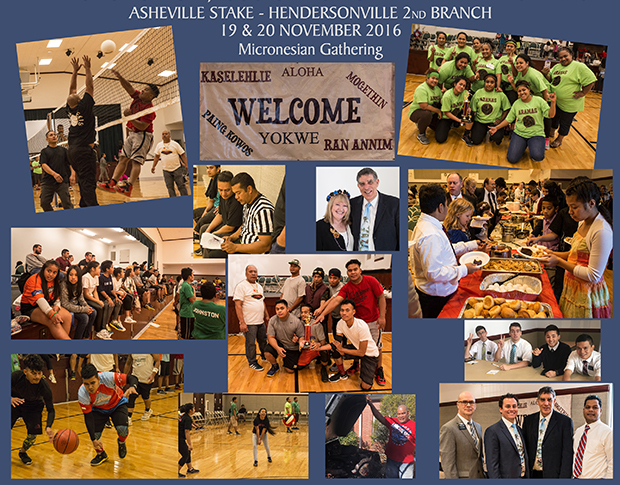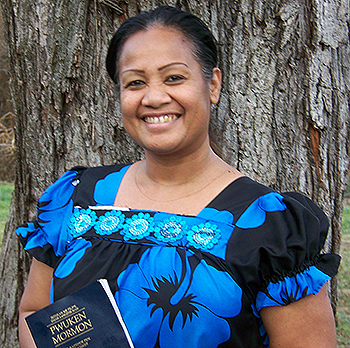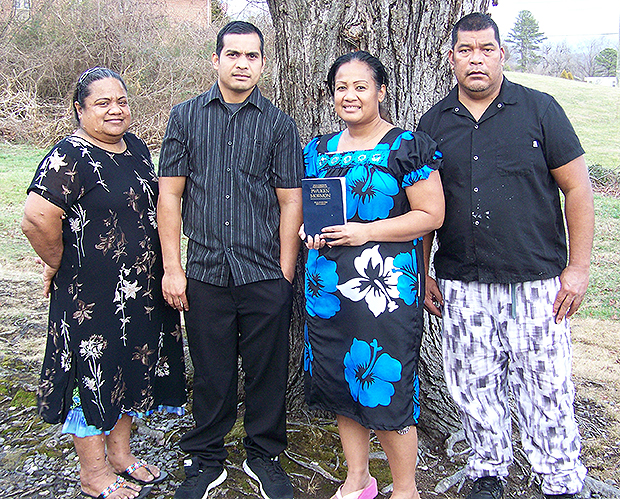Recent Convert Helps Teach Other Micronesians in Their Language
Contributed By Benjamin T. Beasley, Church News contributor

Members of the Micronesian group of the Hendersonville 2nd Branch, Asheville North Carolina Stake.
Article Highlights
- A recent convert from a remote Pacific atoll is helping to carry the message of the gospel to other Micronesians now living in North Carolina.
Related Links
One degree north of the equator in an ocean that covers 60 million square miles—a third of the earth’s surface—lies a small cluster of islets fringing the small atoll of Kapingamarangi. A little more than 500 Kapingas, nearly a third of the Kapinga population in the world, live on the atoll, the coral tip of an ancient underwater volcano that rises a mere 35 inches above sea level.
Life is simple on the atoll, where the natives fish and gather tropical fruit for their livelihood. If parents want their children to receive education beyond primary school, the children have to travel to—and live on—the island of Pohnpei, the capital of one of four states of the Federated States of Micronesia, 500 miles distant. Only a few hundred Kapingas live in the United States.
Kapingamarangi has only one Protestant and one Catholic church. Even if Kapingas know about the LDS Church, the nearest congregation of Latter-day Saints is hundreds of sea miles away; a branch where they could learn the gospel in their native language doesn’t exist. What interest could Kapingas have in The Church of Jesus Christ of Latter-day Saints?
The answer comes from Linda Torres Tihpen, a recent convert to the Church now residing in Hendersonville, North Carolina, who was born in the Mariana Islands and reared on Kapingamarangi from early childhood. Sister Tihpen now lives with about 80 other Micronesians in the heart of LDS cultural and religious activity in the Appalachian Mountains of western North Carolina, near Asheville.
Sister Tihpen knows firsthand what Nephi envisioned when he said the Lord will “remember the isles of the sea; yea, and all the people who are of the house of Israel, will I gather in, saith the Lord” (1 Nephi 19:16), “and they shall come, and see my glory” (Isaiah 66:18).
That type of gathering was the theme of a recent Micronesian gathering Sister Tihpen attended November 19 and 20, 2016, the first of its kind in western North Carolina—and most likely anywhere else in the eastern United States.

Photos from the Micronesian gathering November 19–20, 2016, sponsored by the Hendersonville 2nd Branch, Asheville North Carolina Stake. Photos by Robert Nicholson.

Sister Linda Tihpen with a Pohnpeian Book of Mormon. Photo by Robert Nicholson.
Sister Tihpen left Kapingamarangi when she was 14 to live with relatives in Pohnpei so that she could continue her schooling, which lead to a career in nursing. In 1998 she came to the United States—one of only two from her island to do so. In addition to her native language of Kapingese, she had learned to speak Pohnpeian and English so she could continue her studies. Now she and her husband, Petson, as well as Kadmina Duhm, also from the atoll, live in Hendersonville. All of them are recent converts, among 21 who joined the Church in Asheville this past year.
“I was tired of the old lies, the drinking, the tobacco. We were fighting all the time,” Sister Tihpen said of her relationship with Petson. Their problems were compounded by the fact that they were not yet married and there was no local church where they could receive religious guidance in their own language. “Something had to change,” she said.
That change came a short time later when Clay Alati, a member of the Hendersonville 2nd Branch and a Micronesian who worked with Sister Tihpen in an elderly care facility, told her that she needed to join The Church of Jesus Christ of Latter-day Saints. She resisted at first but eventually, with his encouragement, asked to have the missionaries visit her in her home. “I felt good about the Book of Mormon and accepted it right away, without reservation,” she said.
Sister Tihpen joined the Church in April 2016, still having some questions. “It is difficult for many of my people to understand the missionaries in English,” she explained. But she did recognize the whisperings of the Spirit, which convinced her of the truthfulness of the Book of Mormon. Now she is an active member and a strong witness herself, and she and her husband are preparing to go to the temple.
Brother and Sister Tihpen attended a missionary preparation class each Sunday designed to teach members how to support the local full-time missionaries. Now they help teach the gospel to other Micronesians in words they can understand. The missionaries’ current teaching pool is almost entirely Micronesian—“about 35 of them,” said Elder Constantino, a full-time missionary in the Tennessee Knoxville Mission serving in Hendersonville—“plus others in other units.”

Linda and Petson Tihpen and Kadmina Duhm study the scriptures. Photo by Robert Nicholson.
For the hundreds of Micronesians who live in the Asheville area, nowhere can they hear the gospel preached to them in their own language—except, as Sister Tihpen discovered, in Hendersonville. Under the direction of priesthood leaders, and because of strong local interest, the Hendersonville 2nd Branch of the Asheville North Carolina Stake began to hold an entire three-hour block of services each Sunday in Pohnpeian, in addition to regular services in English with Spanish translation.

Kadmina Duhm, Petson and Linda Tihpen, and Clay Alati. Photo by Robert Nicholson.
That kind of outreach has been well received. Some 92 members, including converts and recently reactivated members, came into the branch in 2016, most of them Micronesian. And the growth trend shows no evidence of slowing down.
“For me, it is just a beginning, and one that will grow,” Sister Tihpen said. It is a beautiful expression, reminiscent of the flowers that bloom on her native island and symbolic of gospel teachings blossoming and growing in the hearts of her people.

Members of the Hendersonville 2nd Branch, Asheville North Carolina Stake, August 21, 2016. Photo by Robert Nicholson.
—Benjamin T. Beasley is president of the Hendersonville 2nd Branch, Asheville North Carolina Stake.
